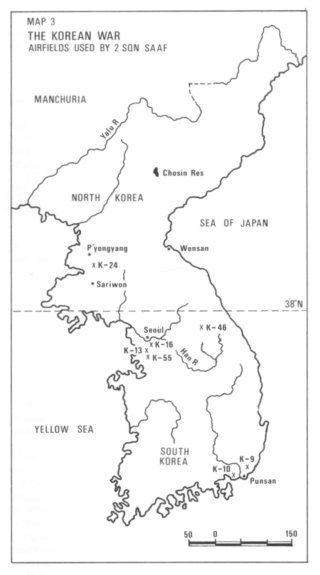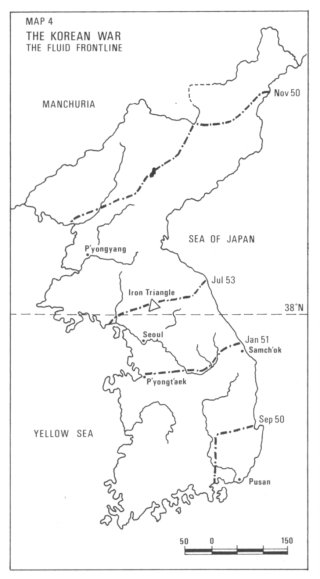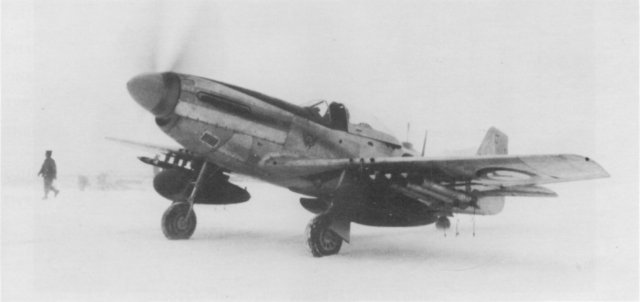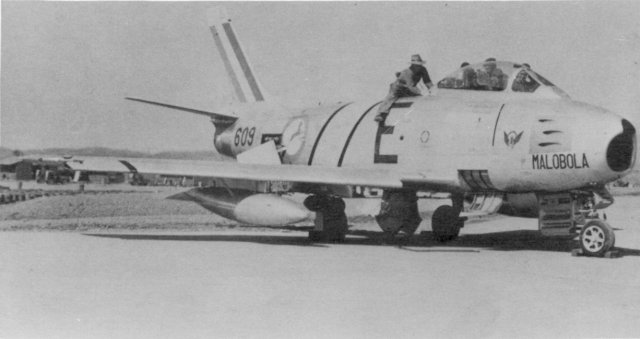

 The South African
The South African
by Professor D.M. Moore, D Litt et Phil
At the outbreak of the Korean War the United Nations Security Council passed a resolution calling for the withdrawal of the North Korean Forces. A request was also made to all UN members for assistance in the execution of this decision.(1) Following a special Cabinet meeting on 20 July 1950 the announcement was made that owing to the great distance between South Africa and Korea, direct military participation in the conflict was both impractical and unrealistic.(2) Further negotiations with the United States Government led to the conclusion that, in spite of the anticipated difficulties, direct military assistance was still considered to be the best form of aid that could be rendered by the South African Government.(3) Following a day-long Cabinet sitting on 4 August it was announced that a SAAF fighter squadron would be made available to the UN effort.(4) For the first time in the history of the Union of South Africa all the parties represented in parliament agreed upon an overseas mission for the country's armed forces.
South Africa's position on a continent susceptible to the rise and spread of Communism necessitated becoming involved in the first UN effort to directly oppose armed aggression in order to avoid future isolation.(5) The Prime Minister, Dr D.F. Malan, made this clear during the no-confidence debate following the commitment of the South African Air Force to the Far East:
'... we have thrown in our forces with UNO, with friendly countries, anti-communist countries, and when aggressive communism has for the first time raised its head, we have sided with the anti-communist countries to combat it. We need those anti-communist countries for our own protection and I think to a fair degree, if all conditions are taken into account, the anti-communist countries also need South Africa in their battle.'(6)
The Prime Minister did not have to exert himself to any great extent in order to defend his government's decision. The opposition agreed in principle and it only called into question the Cabinet's hesitation in reaching a decision and its failure to consult parliament.(7) The lone dissenting voice in the Assembly was that of Mr S. Kahn, Native Representative for Cape Western. He had been a member of the South African Communist Party, which had been dissolved in June 1950 in anticipation of the passing of the Suppression of Communism Act.(8)
Thus it was with the knowledge and sound support of their government and their people that the 50 officers and 157 other ranks of 2 Sqn SAAF sailed from Durban on the Royal Interocean Lines' Tjisadane on 26 September l950.(9) These 207 officers and men had been selected from 1 426 members of the Permanent Force who had initially volunteered for service in the Far East.(10) This initial contingent, which was commanded by Cmdt S. van Breda Theron DSO, DFC, AFC, included many veterans of World War II.(11) After a tedious voyage of six weeks the squadron members arrived in Yokohama Harbour. There they were welcomed by an all-black American brass band which had been especially assembled for the occasion.(12) While in Japan the South Africans were accommodated at the Johnson Air Base just outside Tokyo where they underwent conversion training on the F-51D Mustang and general theatre orientation.(13)
On 16 November 1950 an advance SAAF detachment consisting of 13 officers and 21 other ranks left Japan for Pusan East (K-9) Air Base in Korea. Among the 13 officers were the Squadron Commander and his four Flight Commanders who made the crossing in their own F-51D Mustangs. These pilots were to fly with the USAF pilots in order to familiarize themselves with the local operational conditions before leading their own flights on combat missions.(14) On the morning of 19 November 1950 Cmdt Theron and Capt G.B. Lipawsky took off with two USAF pilots to fly the first SAAF combat sorties of the Korean War.(15)
While operating in Korea 2 Sqn SAAF formed an integral part of the UN Forces. On 7 July 1950 the UN Security Council adopted a resolution for the establishment of a United Nations Command (UNC) under the US President. In terms of the same resolution the US President was empowered to appoint a commander for the UN Forces. The next day Gen Douglas McArthur, who was already Commander-in-Chief of the US Far East Command, was named C-in-C of the UNC. The predominance of the US military structures in the Far East gave rise to the practical expedient of MacArthur assigning a dual role to his already existing Far East Command Headquarters, which he simply re-designated GHQ UNCIFEC. This meant that, for all practical purposes, the non-US contingents assigned to the UN Forces were merely integrated with the existing US military machine.(16) Each 'foreign' contingent attached a senior liaison officer to MacArthur's Headquarters who was responsible for the administration of his particular forces in the theatre. The first Senior Air Liaison Officer appointed in Tokyo to represent the SAAF was Cmdt (later Col) J.D. Pretorius.(17)
The air force component of the UNCIFEC was known as the Far East Air Forces (FEAF). This included a tactical air force, the US Fifth Air Force. For the greater part of the war 2 Sqn SAAF fell under the operational control of the 18th Fighter-Bomber Wing (18 FBW) which was a combat wing of the Fifth Air Force. The tactical role of the South African squadron was spelt out to the Squadron Commander in his formal mission letter which he received from the Commanding Officer of the 18 FBW just one month after becoming operational. He was charged to hold the squadron ready for the following types of operations:
1. The destruction of enemy airpower.
2. The close support of UN ground forces.
3. Maximum range armed reconnaissance and offensive strikes.
4. Interdiction of enemy ground lines and communications to include attacks along avenues of escape for enemy forces.
5. Escort and/or cover for UN air, sea and land forces.
6. The air defence of military installations.(18)

The 2 Sqn pilots became active in Korea at a critical stage in the conflict. In order to appreciate this as well as the task of the squadron in relation to the ground situation, it is necessary to make a brief reference to a general analysis of the course of the war. Based upon the general direction of movement along a north-south axis, the operations of the Korean War can be divided into five distinct phases. These phases are set out in Table 1.(20) The first SAAF combat sorties were flown during the closing stages of Phase Two in support of the UN advance towards the Yalu. The situation, however, changed rather suddenly and a week after becoming operational the 'Flying Cheetahs' found themselves beating off the fresh Chinese troops that were enveloping the withdrawing UN ground forces. Once the Eighth Army had consolidated its positions along a line over 100 km south of the 38th parallel, from P'yongt'aek on the West Coast to Samch'ok on the East Coast, the war settled down to its two longest phases. Phase Four lasted for more than nine months and consisted of the gradual UN fight back to the 38th parallel in the face of determined Communist resistance. Phase Five was characterized by a stalemate along a line approximating the 38th parallel, with neither side wanting to incur heavy losses while an armistice was being negotiated. (Map 4) At this stage the FEAF became the United Nations main offensive weapon, and 2 Sqn SAAF settled down to the business of a tactical air force unit in combat.
These phases can be further sub-divided into various periods, mainly on the basis of the several tasks assigned to 18 FBW, and of the ground situation. The latter was dominated by the offensive thrusts which were undertaken by both sides within the broader context of the conflict. An analysis of 2 Sqn combat sorties during the various periods of Phases Four and Five is given in Table 2.(21) The figures are indicative of a number of significant features of the SAAF combat experience in Korea. In general, it is clear that the main task of the squadron was the interdiction of enemy supply routes which not only accounted for approximately 61,45% of SAAF combat sorties, but which reached an early peak from January to May 1951 (78% and 82%).
Interdiction can be defined as any air action which prevents, or delays, or destroys enemy movements of men and supplies to the battle zone. The aim of interdiction is to isolate the battlefield from the rear zones.(22) The effectiveness of interdiction missions as opposed to close air support missions remained a controversial point throughout the Korean War.(23) During the first half of 1951 the opinions of the protagonists of interdiction as to the advantages of striking Communist troops and supplies while they were concentrated for transport, prevailed. Consequently this period saw 18 FBW and 2 Sqn directing the bulk of their effort against enemy supply lines. The typical interdiction mission was the armed reconnaissance patrol, which was usually undertaken by flights of four or two aircraft each armed with two napalm bombs, 127 mm rockets and 12,7 mm machine guns, or with variations of these weaponloads. These aircraft ranged along the main north-south supply routes and along the secondary lateral routes searching for targets of opportunity. 2 Sqn paid particular attention to the double railway line and the road in the West between Seoul and Sariwon, and to the Eastern route between Wonsan and the Chosin Reservoir.


A SAAF F-S1D Mustang armed with rockets
and napalm bombs taxies out at Sowon (K13) Air Base.
The pattern of events which unfolded during the autumn of 1952 has a strong resemblance to that of the previous year. The peace talks faltered once again during September 1952 and collapsed once more a month later, with each side reverting to an increase in military pressure in order to force its opponent back to the conference table in a more 'reasonable' frame of mind. The battle for tactically situated outposts along the MLR erupted again in September and during the following month some of the heaviest ground fighting of the entire war took place along the base of the 'Iron Triangle'.(27) 2 Sqn SAAF became involved in these outpost battles. The nature of these operations was such that both sides commonly launched first and last light attacks. Consequently, the Fifth Air Force required a certain number of its fighter-bombers to be on 'Strip Alert' during the twilight and dawn hours. A 'Strip Alert' flight would follow all the normal pre-flight procedures, taxi to the end of the runway, shutdown the engines and wait, with the pilots remaining ready in the cockpits. Once called, the flight would be air briefed to a specific controller, who then directed it to a forward controller, who in turn would indicate the target.(28)
A remarkable feature of SAAF activities in Korea, as indicated by Table 2 is the allocation of 32% of the squadron's effort to counter-air operations during 1953. The counter-air missions which were undertaken by the FEAF in Korea included;
On rare occasions during 1951 and 1952, and for a short period during March 1953, when the newly acquired F-86F Sabres first entered combat, 2 Sqn aircraft were assigned to counter-air missions solely concerned with fighter sweeps and interceptions. Later, however, they were freqeuntly directed against enemy airfields and it was this type of mission which accounted for the large percentage of 2 Sqn effort allocated to counter-air sorties during 1953.

A SAAF F-86F Sabre in Korea.
On the last day of the war the SAAF recorded the largest number of combat sorties flown on Sabres during the course of a single day of operations. On that day they used 14 operational aircraft to fly 41 combat sorties. These last missions were directed against any Communist attempt to bring combat aircraft into North Korea and consisted of fighter sweeps along the Yalu and Ch'ongch'on Rivers. Thus 2 Sqn ended the war with a maximum effort on a type of operation not at all typical of their general experience in Korea.(33)
During more than thirty months of operational deployment in the Far East the officers and men of the SAAF contingent demonstrated a thorough-going professionalism in their approach to the assigned task. This was characterized above all by a flexibility which enabled them to adapt to changing circumstances within the UN organization of which they were part. Their flexibility was also demonstrated by their ability to deal with novel and frequently changing enemy tactics as well as with a hostile physical environment.
A consideration of the following data will assist in forming an appreciation of the measure of their success. The various sources yield slight and insignificant variations in the total number of sorties credited to the pilots of 2 Sqn during the course of the war. The squadron War Diary lists 10 597 sorties on Mustangs,(34) while the corresponding figure given in the Mission Returns and Statistical Data Tables is 10 569.(35) Totals for the number of combat sorties flown on Sabres vary between 1 427 and 1 454.(36) The South Africans thus flew approximately 12 000 of a grand total of 352 023 operational sorties undertaken by fighter-bomber units in Korea. This represents 3,423% of all fighter-bomber sorties and 1,158% of all FEAF combat sorties.(37)
The effect of these operations on the enemy can be estimated from Table 3.(38) It is based on the fact that from June 1950 until July 1953 FEAF possessed or controlled an average of 62 squadrons with 1 249 aircraft on strength at any one time.(39) When the percentages in the last column of this table are considered in the light of the estimate that the SAAF flew 1,158% of the FEAF sorties it is clear that the squadron operated with an above average effectiveness. This achievement had its price, however, for whilst the other UN squadrons averaged 19 casualties (Killed and Missing in Action), the South African average was 35, including one member killed in a ground crew accident.(40) These sacrifices were not made in vain. Militarily, the SAAF had contributed to the repulse of an act of Communist aggression, while politically the South African Government and nation had clearly demonstrated their will to resist.
| TABLE 1 THE MAIN PHASES OF THE KOREAN WAR | ||||
|---|---|---|---|---|
| PHASE | MAIN MOVEMENT | FROM | TO | DURATION |
| ONE | The North Korean Invasion | 25 Jun 1950 | 15 Sep 1950 | 3 mths |
| TWO | The UN advance to the Yalu | 15 Sep 1950 | 25 Nov 1950 | 2,5 mths |
| THREE | The UN withdrawal and consolidation along the line P'yongt'aek - Samch'ok |
26 Nov 1950 | 25 Jan 1951 | 2 mths |
| FOUR | The UN return to the 38th parallel | 25 Jan 1951 | 12 Nov 1951 | 9,5 mths |
| FIVE | Stalemate along the MLRl | 12 Nov 1951 | 27 Jul 1953 | 19,5 mths |
| TABLE 2 PHASES FOUR AND FIVE: ANALYSIS OF COMBAT SORTIES OF 2 SQN SAAF (Approximate percentages of total for period) | |||||||
|---|---|---|---|---|---|---|---|
| PHASE | PERIOD | FROM | TO | INTER DICTION | CLOSE AIR SUPPORT | RESCAP | COUNTER -AIR |
| FOUR | 1 | 25 Jan 51 | 28 Feb 51 | 78 | 21,6 | 0,4 | |
| 2 | 1 Mar 51 | 29 May 51 | 82 | 16 | 2 | ||
| 3 | 20 May 51 | 31 Aug 51 | 67 | 23 | 2 | 8 | |
| 4 | 1 Sep 51 | l2 Nov 51 | 57,6 | 38,4 | 3,4 | 0,6 | |
| FIVE | 1 | 13 Nov 51 | 30 Apr 52 | 67 | 23 | 10 | |
| 2 | 1 May 52 | 30 Aug 52 | 60 | 28 | 11 | 1 | |
| 3 | 1 Sep 52 | 3l Dec 52 | 39 | 46 | 12 | 3 | |
| 4 | 1 Jan 53 | 27 Jul 53 | 41 | 25,5 | 1,5 | 32 | |
| BOTH PHASES | 61,45 | 27,69 | 5,29 | 5,45 | |||
| TABLE 3 CLAIMS BY UN AIR FORCES AND 2 SQN SAAF (Targets destroyed) | ||||
|---|---|---|---|---|
| TARGET | UNC TOTAL | UNC AVERAGE (62 SQUADRONS) | 2 SQN TOTAL | 2 SQN AS % OF UNC TOTAL |
| Vehicles | 82 920 | 1 337 | 615 | 0,742 |
| Tanks | 1 327 | 21 | 18 | 1,356 |
| Field and Anti-aircraft guns | 8 663 | 139 | 280 | 3,232 |
| Locomotives | 962 | 16 | 4 | 0,416 |
| Rolling Stock | 10 407 | 168 | 200 | 1,921 |
| Tunnel Entrances | 65 | 1 | 4 | 6,154 |
| Bridges | 1153 | 19 | 46 | 3,989 |
| Buildings | 118 231 | 1 907 | 3 021 | 2,555 |
| Railcuts | 28 621 | 461 | 472 | 1,647 |
| Enemy Killed in action | 184 808 | 2 980 | 2 276 | 1,232 |
References
1. J.F. Schnabel, United States Army in the Korean War Policy and Direction: The First Year,
(Washington, US Government, 1972), pp.66-67
2. D.F. Malan, Speech in the House of Assembly, 31.1.1951, Hansard, col. 506.
3. F.C. Erasmus, Speech in the House of Assembly, 1.2.1951, Hansard, col. 545-546.
4. Eastern Province Herald, 5.8.1950.
5. The Star, 5.8.1950; D.F. Malan, Speech in the House of Assembly, 26.1.1951, Hansard,
col. 180-181.
6. D.F. Malan, Speech in the House of Assembly, 26.1.1951, Hansard, col. 180-181.
7. A.G. Barlow, Speech in the House of Assembly, 22.1.1951, Hansard, col. 35;
M. Kentridge, Speech in the House of Assembly, 22.1.1951, Hansard, col. 41;
J.H. Russell, Speech in the House of Assembly, 22.1.1951, Hansard, col. 46;
P.A. Moore, Speech in the House of Assembly, 25.1.1951, Hansard, col. 171.
8. S. Kahn, Speech in the House of Assembly, 26.1.1951, Hansard, col. 232.
9. SADF INFORMATION CENTRE: WAR DIARIES AND MISSIONS, SAAF KOREA, (WDM): Box 1, 2 Sqn War Diary, 25.9.1950.
10. SADF INFORMATION CENTRE: 2 SQN KOREA, (2 Sqn K): Box 64, FEAF Historical Office AG,
South African Air Force Far East Contingent War History, p.1; F.C. Erasmus, Speech in the House of
Assembly, 1.2.1951, Hansard, col. 546.
11. WDM, Box 1, 2 Sqn War Diary, 1-4.9.1951; S.v.B. Theron, Recorded Interview, Johannesburg, 13.1.1982.
12. WDM, Box 1, 2 Sqn War Diary, 4.11.1950; J.H. Kruger, Recorded Interview, Pretoria, 16.3.1981;
M.D.V. Cloete, Recorded Interview, Pretoria, 31.3.1981; S.J.W. Inglesby, Recorded Interview,
Johannesburg, 31.3.1981.
13. WDM, Box 1, 2 Sqn War Diary, 4-31.11.1950; WDM, Box 2, 2 Sqn War Diary, 1-19.12.1950.
14. WDM, Box 1, 2 Sqn War Diary, November 1950, Appendix Q, 2 Sqn Operation Order 1/50,
15.11.1950; WDM, Box 1, 2 Sqn War Diary, 16.11.1950; WDM, Box 9, SAAF Liaison HQ War
Diary, 16.11.1950; S.v.B. Theron, Recorded Interview, Johannesburg, 13.1.1982.
15. WDM, Box 1, 2 Sqn War Diary, 19.11.1950.
16. R.F. Futrell, L.S. Moseley, A.F. Simpson. The United States Air Force in Korea, 1950-1953,
(New York, Duell, Sloan and Pearce, 1961), pp.28, 39; W.G. Hermes, United States Army in the Korean
War: Truce Tent and Fighting Front, (Washington, US Government, 1966), p.53
17. SADF INFORMATION CENTRE: ADJUTANT-GENERAL, (AG), Box 228, AG(3)1906114 Vol.1,
General Instruction, Korea Campaign 2.9.1950; SADF INFORMATION CENTRE: SENIOR AIR LIAISON OFFICER, (SALO), Box 7, SALO/S/S/1/ORG, Organisasie en Administratiewe Instruksie, Afdeling 1, Nommer 26, 7.9.1950; AG:
Box 229, AG(3)1906/14/2 Vol.1, DGAF-AG, 7.9.1950.
18. WDM, Box 2, 2 Sqn War Diary, 19.12.1950; WDM, Box 2, 2 Sqn War Diary, December 1950, Appendix G, 18th Fighter-Bomber Wing, Operational Procedure, 15.12.1950.
19. WDM, Box 2, 2 Sqn War Diary, 14-26.12.1950.
20. D.M. Moore, The Role of the South African Air Force in the Korean War, 1950-1953, (Unpub. D.Litt
et Phil Thesis, Unisa, 1982), pp.63-64.
21. Moore, Op.cit., pp.197,254,289,359,372,413.
22. Futrell, et al., Op. cit., p.117.
23. R.F. Futrell and A.F. Simpson. Air War in Korea II, Air University Quarterly Review, IV, 3, Fall 1951, pp.63,67.
24. WDM, Box 9, SAAF Liaison HQ War Diary, 4.4.1951.
25. J. Miller, O.J. Carroll, M.E. Tackley. Korea, 1950-1953, (Washington, US Government, (no
date)), pp.116-117; Hermes, Op.cit., p.96.
26. WDM, Box 18, Debriefing Forms SAAF 220, September 1951; WDM, Box 19, Debriefing Forms
SAAF 220, October 1951; WDM, Box 21, Debriefing Forms SAAF 220, November 1951.
27. Miller, Op.cit., pp.270-271; Hermes, Op.cit.,
pp.303-305, 310-318; Futrell, et al., Op. cit., pp.494-495.
28. 2 Sqn K: Box 18, 2 SQDN/271A1R, 'Strip Alert'; E.A.C. Pienaar, Recorded Interview, Pretoria,
24.9.1981.
29. Anon., 'The Air-Ground Operation in Korea', Air Force, XXXIV, 3, March 1951, p.24.
30. Futrell, et al. Op. cit., p.636; Hermes, Op.cit., p.173.
31. Futrell, et al., Op. cit., pp.636-637.
32. WDM, Box 8, 2 Sqn War Diary, May 1953. WDM, Box 34, 2 Sqn War Diary, June 1953. WDM, Box 35, 2 Sqn War Diary, July 1953.
33. WDM, Box 35, 2 Sqn War Diary, 27.7.1953.
34. 2 Sqn K: Box 54, 2 Sqn War Diary, 27.12.1952.
35. WDM, Box 256, Mission Returns, 31.8.1952; 2 Sqn K: Box 36, 2 SDQDN/S/82514/ORG, Statistical Data, September-December 1952.
36. WDM, Box 35, 2 Sqn War Diary, 28-31.7.1953; WDM, Box 35, 2 Sqn War Diary, August 1953; 2
Sqn K, Box 36, 2 SQDN/S/82514/ORG, Statistical Data, March-September 1953; SADF INFORMATION CENTRE.' 2 SQN UNIT FILE, Summary of South African Operations by Quarter, July 1950 through 17 July 1953.
37. Moore, Op.cit., p.438.
38. Moore, Op.cit., p.438.
39. Futrell, et al., Op. cit., p.644.
40. Moore, Op.cit., p.439.
Editors note: Professor Moore's doctoral thesis on the South African Air Force in Korea is shortly to be published in its entirety by Galago Publishing (Pty) Ltd.
Return to Journal Index OR Society's Home page
South African Military History Society / scribe@samilitaryhistory.org